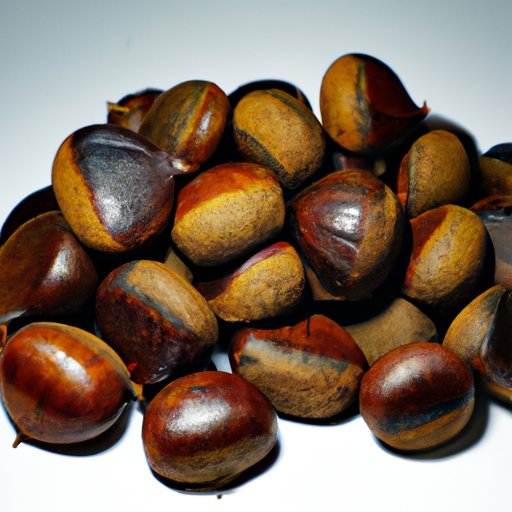
Introduction
Fall is the season for chestnuts! Whether you’re throwing them into your holiday stuffing or enjoying them as a midday snack, there’s no denying the charm of these versatile nuts. In this article, we’ll go through the different ways to prepare and cook chestnuts and provide you with recipes, health benefits, and pairing suggestions.
Step-by-step guide
Before you start cooking chestnuts, you should know how to prepare them correctly. Begin by rinsing them in cold water, then use a small, sharp knife to make a cross-shaped cut on one side of each chestnut. This will prevent them from bursting while cooking. Now, you’re ready to cook them!
The most popular cooking methods for chestnuts include roasting, boiling, or baking. To roast chestnuts, preheat your oven to 400°F. Spread the chestnuts out on a baking sheet with the flat side facing down. Bake for 15-20 minutes, then remove from the oven, and let them cool before diving in. If you prefer boiling, bring a pot of water to a boil and add the chestnuts. Boil for 5-10 minutes, then remove from heat, and let them cool. Lastly, you can bake chestnuts at home, put them in a baking dish, add water, and bake them at 425°F for 20-25 minutes.
Although chestnuts are not challenging to cook, they do require some careful attention. For instance, always check the chestnuts while roasting or baking to prevent them from getting burned on one side. Another tip is to avoid overcooking, as it turns them dry and tough. If you experience such issues, lightly soak them in water for a minute to hydrate and moisten them.
Recipe roundup
Now it’s time to look at some chestnut recipes! Here are some of our top picks:
Appetizers
- Roasted Chestnut and Apple Soup: This creamy soup is the perfect way to start any meal. It combines roasted chestnuts, tender apples, and rich cream for a fragrant, satisfying appetizer.
- Chestnut and Ricotta Crostini: These crostinis are crispy, rich, and perfect for fall. The combination of chestnuts and ricotta results in a creamy taste and a crunchy texture that will satisfy any taste preference.
Entrees
- Roast Pork Loin with Chestnut Stuffing: This classic dish is traditional for the holiday season. It combines a juicy pork loin roast with a savory chestnut stuffing that will make for a festive meal.
- Chestnut Gnocchi with Sage Butter Sauce: This vegan-friendly entree is a delicious option for a cozy dinner on a chilly night.
Desserts
- Chestnut Creme Brulee: This smooth, creamy, nutty creme brulee ticks all the boxes! Serve it at any dinner party for an impressive, yet straightforward dessert.
- Mont Blanc Cake: This classic French cake features chestnut cream and meringue, making it an ideal complement to afternoon tea or a fancy dessert.
History lesson
Chestnuts have been cultivated for over 2,500 years and have been prized since ancient times for their remarkable taste, versatility, and nutritional value. In Europe, chestnuts were a staple in pre-industrial societies, and they are still critical in many traditional regional cuisines today.
When the potato failed in the 19th century, the chestnut became a means of survival for people in the impoverished regions of southern Europe. Similarly, in East Asia, chestnuts were a vital source of energy and nutrition for the Japanese army during World War II. Today, chestnuts are commercially cultivated across Asia, Europe, and America.
They are a great source of vitamins, minerals, and other antioxidants, a more excellent dietary source of carbohydrates than rice, and a tasty option for gluten-free eaters.
Healthy eating guide
These superfoods are also excellent for your health! Chestnuts have a low glycemic index, which means they won’t cause a sudden spike in blood sugar levels. Hence they are a perfect energy booster for anyone looking to maintain their blood sugar levels. They are also naturally cholesterol-free and gluten-free, making them an excellent choice for anyone with dietary restrictions. Whether you decide to indulge in a comforting cup of chestnut soup or a heartwarming bowl of chestnut chili, you’re getting a solid dose of vitamins, minerals, and other antioxidants that promote good health and energy levels.
You can also integrate chestnuts into your everyday diet in several ways. You can enjoy roasted chestnuts as a snack or add them to salads for a sweet and nutty crunch. Furthermore, they are also great in smoothies, or you can blend them into flour and use it as a gluten-free alternative in baking recipes. They are versatile and delectable!
Pairing guide
Chestnuts are a staple of both sweet and savory dishes, so it’s worthwhile to pair them with complementary flavors.
For savory dishes, chestnuts pair exceptionally well with sweet and tangy flavors such as fig or pomegranate. You can also mix them up with a combination of fresh herbs, such as rosemary, thyme and sage, or use them as a filling in savory dishes like ravioli or gratin. In sweet recipes, use chestnuts with spiced flavors like cinnamon, nutmeg, and clove, or pair them with fruits like blackberries or cranberries.
Chestnuts can complement your cheese boards as well! Consider incorporating chestnuts with blue cheese, camembert, or parmesan cheese. They make for an exciting, unconventional, and delicious combo.
Conclusion
Now that you have a comprehensive guide on cooking with chestnuts, it’s time to get in the kitchen and start experimenting! Whether you’re roasting, boiling, or baking, chestnuts are a fall staple that should not be missed. Try out old family recipes or experiment with new ones. Who knows? You might make a new favorite dish.
For more recipe ideas and tips, head over to your favorite culinary blogs or websites for inspiration.




